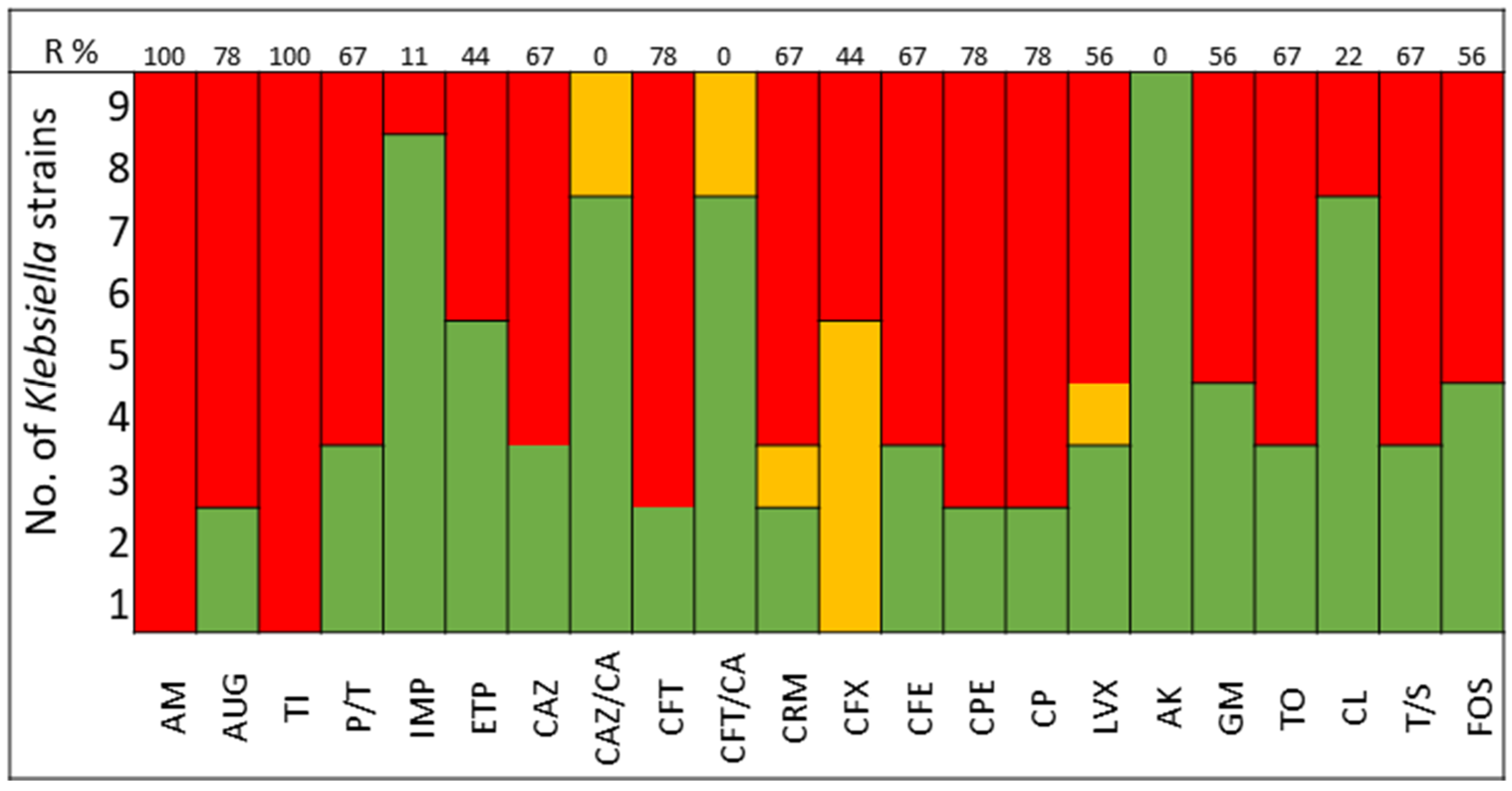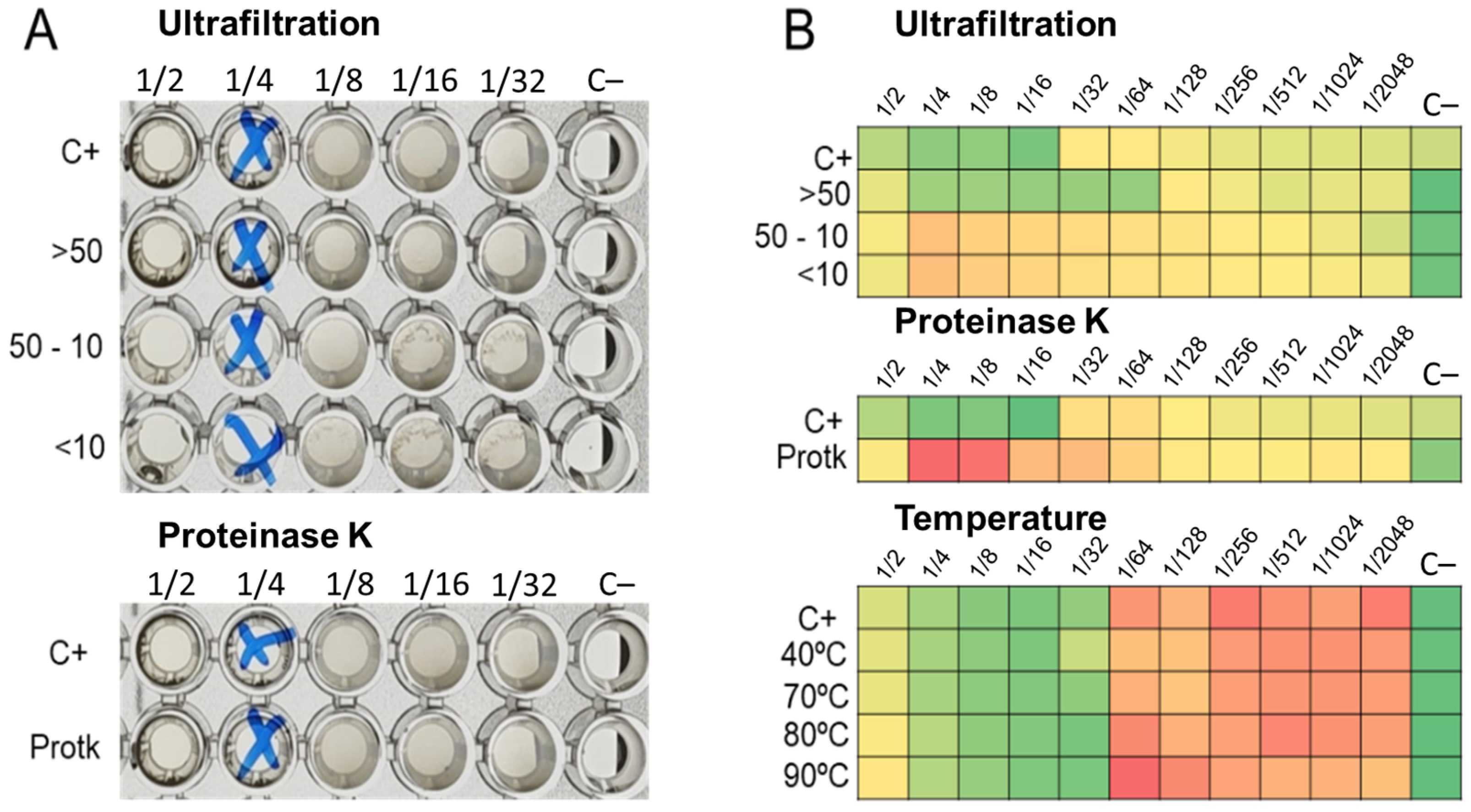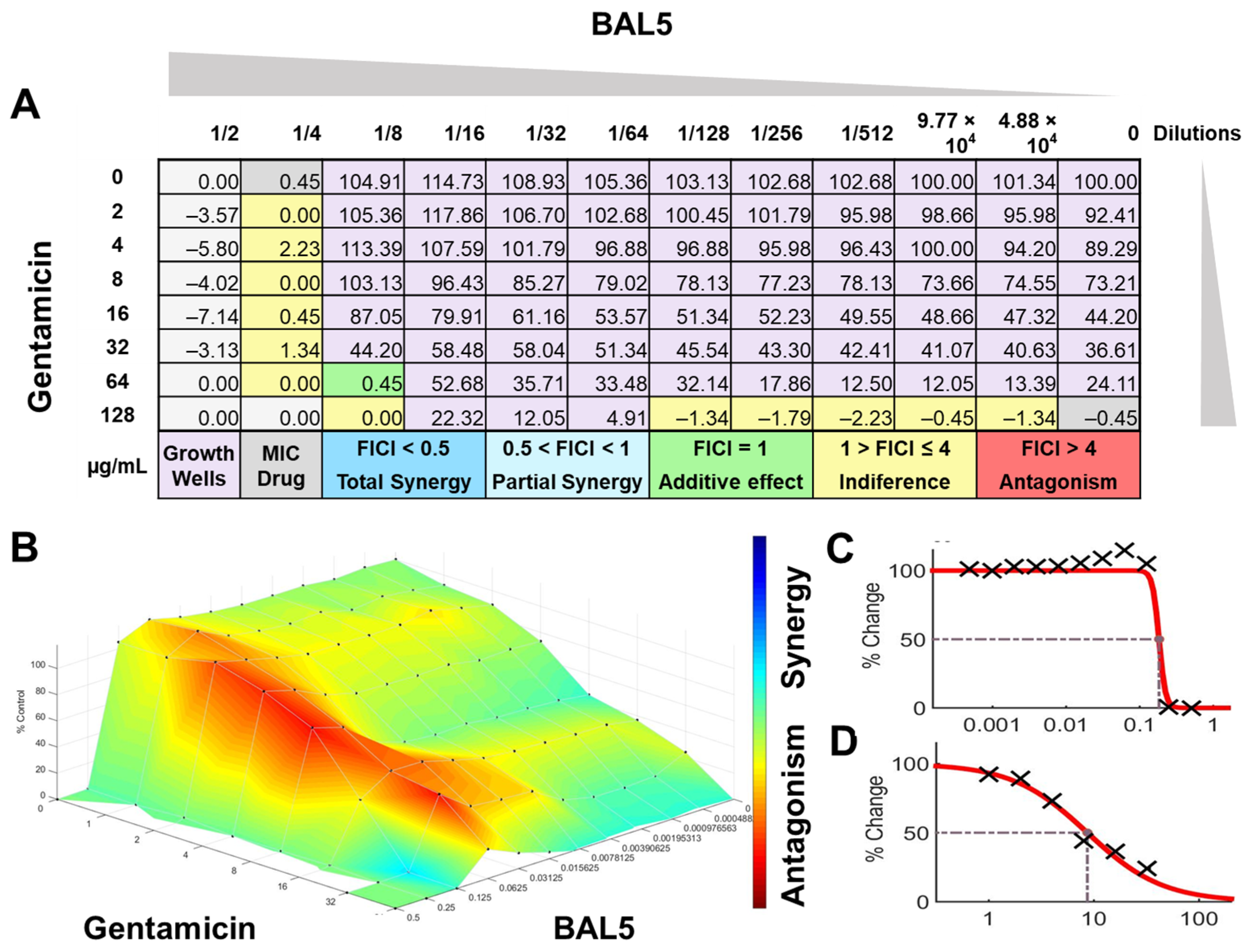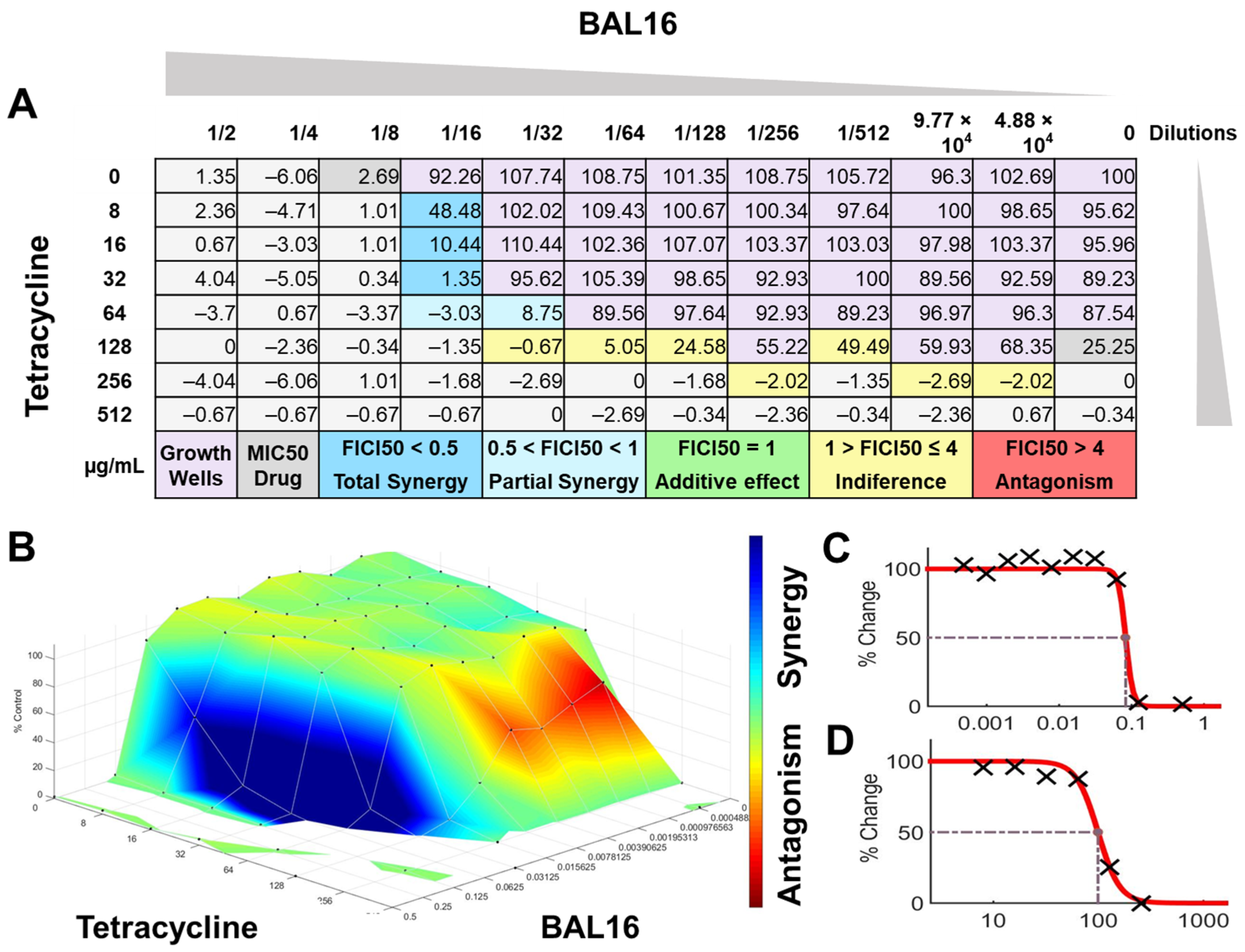Synergistic Activity of Ingulados Bacteria with Antibiotics against Multidrug-Resistant Pathogens
Abstract
1. Introduction
2. Results
2.1. Susceptibility Profile of the Clinical Bacterial Strains Selected
2.2. Antimicrobial Assays of CFCS of the Lactic Acid Bacteria Selected
2.3. Single Dose Synergy Screening for Combination LAB CFCS with Antimicrobials
2.4. Effect of Treated LABs CFCS on Its Activity
2.5. Bioinformatic Assay
2.6. Synergy Analysis by Checkerboard Method
2.6.1. Fractional Inhibitory Concentration Index (FICI)
- Antimicrobial activities of individual compounds
- FICI analysis through CMI absolute value interpretation
- FICI analysis through MIC50 interpretation
2.6.2. Surface Analysis
3. Discussion
3.1. Lactic Acid Bacteria: Properties and Therapeutic Applications
3.2. Interactions of Antimicrobial Peptides (AMPs) and Bacteriocins with Bacteria and Antibiotics
3.3. Synergies and Antagonisms between LAB Compounds and Antibiotics
3.4. Mechanisms of Action and Therapeutic Potential
4. Materials and Methods
4.1. Clinical Bacterial Strains, Identification and Sensibility
4.2. Lactic Acid Bacteria (LAB) Selection, Culture Conditions and Collection of Cell Free Culture Supernatant (CFCS)
4.3. Antimicrobial Activity Assays of LAB Supernatant by Microdilution Technique
4.4. Single Dose Synergy Screening for Combination LAB CFCS with Antimicrobials
4.5. CFCS LABs Treatments
- Proteinase K
- Temperature
- Ultrafiltration of Supernatants
- Precipitation with Ammonium Sulphate
4.6. Bioinformatic Assay
4.7. Checkerboard Method for Study of Synergistic Interactions
4.7.1. Fractional Inhibitory Concentration Index (FICI)
4.7.2. Surface Analysis
5. Conclusions
Author Contributions
Funding
Institutional Review Board Statement
Informed Consent Statement
Data Availability Statement
Conflicts of Interest
References
- WHO. Global Antimicrobial Resistance and Use Surveillance System (GLASS) Report 2022; World Health Organization: Geneva, Switzerland, 2022. [Google Scholar]
- Tackling Antimicrobial Resistance: Council Adopts Recommendation. European Council. 3 June 2023. Available online: https://Www.Consilium.Europa.Eu/En/Press/Press-Releases/2023/06/13/Tackling-Antimicrobial-Resistance-Council-Adopts-Recommendation/ (accessed on 14 November 2021).
- Lack of Innovation Set to Undermine Antibiotic Performance and Health Gains. Available online: https://www.who.int/news/item/22-06-2022-22-06-2022-lack-of-innovation-set-to-undermine-antibiotic-performance-and-health-gains (accessed on 14 November 2023).
- Silver, L.L. Challenges of Antibacterial Discovery. Clin. Microbiol. Rev. 2011, 24, 71–109. [Google Scholar] [CrossRef] [PubMed]
- MacNair, C.R.; Tsai, C.N.; Rutherford, S.T.; Tan, M.-W. Returning to Nature for the Next Generation of Antimicrobial Therapeutics. Antibiotics 2023, 12, 1267. [Google Scholar] [CrossRef] [PubMed]
- Miethke, M.; Pieroni, M.; Weber, T.; Brönstrup, M.; Hammann, P.; Halby, L.; Arimondo, P.B.; Glaser, P.; Aigle, B.; Bode, H.B.; et al. Towards the Sustainable Discovery and Development of New Antibiotics. Nat. Rev. Chem. 2021, 5, 726–749. [Google Scholar] [CrossRef] [PubMed]
- Bravo, M. Caracterización de Bacterias Ácido-Lácticas Con Propiedades Antimicrobianas e Inmunomoduladoras y Su Investigación Aplicada En Sanidad Animal. Ph.D. Thesis, Universidad de Extremadura, Badajoz, Spain, 2021. [Google Scholar]
- Reis, J.A.; Paula, A.T.; Casarotti, S.N.; Penna, A.L.B. Lactic Acid Bacteria Antimicrobial Compounds: Characteristics and Applications. Food Eng. Rev. 2012, 4, 124–140. [Google Scholar] [CrossRef]
- Gradisteanu Pircalabioru, G.; Popa, L.I.; Marutescu, L.; Gheorghe, I.; Popa, M.; Czobor Barbu, I.; Cristescu, R.; Chifiriuc, M.-C. Bacteriocins in the Era of Antibiotic Resistance: Rising to the Challenge. Pharmaceutics 2021, 13, 196. [Google Scholar] [CrossRef] [PubMed]
- Bucheli, J.E.V.; Fugaban, J.I.I.; Holzapfel, W.H.; Todorov, S.D. Combined Action of Antibiotics and Bacteriocins against Vancomycin-Resistant Enterococci. Microorganisms 2022, 10, 1423. [Google Scholar] [CrossRef] [PubMed]
- Mora-Gamboa, M.P.C.; Rincón-Gamboa, S.M.; Ardila-Leal, L.D.; Poutou-Piñales, R.A.; Pedroza-Rodríguez, A.M.; Quevedo-Hidalgo, B.E. Impact of Antibiotics as Waste, Physical, Chemical, and Enzymatical Degradation: Use of Laccases. Molecules 2022, 27, 4436. [Google Scholar] [CrossRef]
- Naskar, A.; Kim, K. Potential Novel Food-Related and Biomedical Applications of Nanomaterials Combined with Bacteriocins. Pharmaceutics 2021, 13, 86. [Google Scholar] [CrossRef]
- Assoni, L.; Milani, B.; Carvalho, M.R.; Nepomuceno, L.N.; Waz, N.T.; Guerra, M.E.S.; Converso, T.R.; Darrieux, M. Resistance Mechanisms to Antimicrobial Peptides in Gram-Positive Bacteria. Front. Microbiol. 2020, 11, 593215. [Google Scholar] [CrossRef]
- Riley, M.A.; Robinson, S.M.; Roy, C.M.; Dorit, R.L. Rethinking the Composition of a Rational Antibiotic Arsenal for the 21st Century. Future Med. Chem. 2013, 5, 1231–1242. [Google Scholar] [CrossRef]
- Hols, P.; Ledesma-García, L.; Gabant, P.; Mignolet, J. Mobilization of Microbiota Commensals and Their Bacteriocins for Therapeutics. Trends Microbiol. 2019, 27, 690–702. [Google Scholar] [CrossRef] [PubMed]
- Biswas, K.; Upadhayay, S.; Rapsang, G.F.; Joshi, S.R. Antibacterial and Synergistic Activity Against β-Lactamase-Producing Nosocomial Bacteria by Bacteriocin of LAB Isolated From Lesser Known Traditionally Fermented Products of India. HAYATI J. Biosci. 2017, 24, 87–95. [Google Scholar] [CrossRef]
- Bravo, M.; Combes, T.; Martinez, F.O.; Risco, D.; Gonçalves, P.; Garcia-Jimenez, W.L.; Cerrato, R.; Fernandez-Llario, P.; Gutierrez-Merino, J. Wildlife Symbiotic Bacteria Are Indicators of the Health Status of the Host and Its Ecosystem. Appl. Environ. Microbiol. 2022, 88, e01385-21. [Google Scholar] [CrossRef] [PubMed]
- Ayivi, R.D.; Gyawali, R.; Krastanov, A.; Aljaloud, S.O.; Worku, M.; Tahergorabi, R.; da Silva, R.C.; Ibrahim, S.A. Lactic Acid Bacteria: Food Safety and Human Health Applications. Dairy 2020, 1, 202–232. [Google Scholar] [CrossRef]
- Simons, A.; Alhanout, K.; Duval, R.E. Bacteriocins, Antimicrobial Peptides from Bacterial Origin: Overview of Their Biology and Their Impact against Multidrug-Resistant Bacteria. Microorganisms 2020, 8, 639. [Google Scholar] [CrossRef] [PubMed]
- Erdem Büyükkiraz, M.; Kesmen, Z. Antimicrobial Peptides (AMPs): A Promising Class of Antimicrobial Compounds. J. Appl. Microbiol. 2022, 132, 1573–1596. [Google Scholar] [CrossRef] [PubMed]
- Sang, Y.; Blecha, F. Antimicrobial Peptides and Bacteriocins: Alternatives to Traditional Antibiotics. Anim. Health Res. Rev. 2008, 9, 227–235. [Google Scholar] [CrossRef]
- Pérez-Ramos, A.; Madi-Moussa, D.; Coucheney, F.; Drider, D. Current Knowledge of the Mode of Action and Immunity Mechanisms of LAB-Bacteriocins. Microorganisms 2021, 9, 2107. [Google Scholar] [CrossRef]
- Zhu, Y.; Hao, W.; Wang, X.; Ouyang, J.; Deng, X.; Yu, H.; Wang, Y. Antimicrobial Peptides, Conventional Antibiotics, and Their Synergistic Utility for the Treatment of Drug-Resistant Infections. Med. Res. Rev. 2022, 42, 1377–1422. [Google Scholar] [CrossRef]
- Amaning Danquah, C.; Minkah, P.A.B.; Osei Duah Junior, I.; Amankwah, K.B.; Somuah, S.O. Antimicrobial Compounds from Microorganisms. Antibiotics 2022, 11, 285. [Google Scholar] [CrossRef]
- Cintas, L.M.; Casaus, M.P.; Herranz, C.; Nes, I.F.; Hernández, P.E. Review: Bacteriocins of Lactic Acid Bacteria. Food Sci. Technol. Int. 2001, 7, 281–305. [Google Scholar] [CrossRef]
- Zharkova, M.S.; Orlov, D.S.; Golubeva, O.Y.; Chakchir, O.B.; Eliseev, I.E.; Grinchuk, T.M.; Shamova, O.V. Application of Antimicrobial Peptides of the Innate Immune System in Combination with Conventional Antibiotics—A Novel Way to Combat Antibiotic Resistance? Front. Cell. Infect. Microbiol. 2019, 9, 128. [Google Scholar] [CrossRef]
- Dosler, S.; Gerceker, A.A. In Vitro Activities of Nisin Alone or in Combination with Vancomycin and Ciprofloxacin against Methicillin-Resistant and Methicillin-Susceptible Staphylococcus aureus Strains. Chemotherapy 2011, 57, 511–516. [Google Scholar] [CrossRef] [PubMed]
- Meng, F.; Nie, T.; Lyu, Y.; Lyu, F.; Bie, X.; Lu, Y.; Zhao, M.; Lu, Z. Plantaricin A Reverses Resistance to Ciprofloxacin of Multidrug-Resistant Staphylococcus aureus by Inhibiting Efflux Pumps. Environ. Microbiol. 2022, 24, 4818–4833. [Google Scholar] [CrossRef] [PubMed]
- Goldberg, K.; Sarig, H.; Zaknoon, F.; Epand, R.F.; Epand, R.M.; Mor, A. Sensitization of Gram-Negative Bacteria by Targeting the Membrane Potential. FASEB J. Off. Publ. Fed. Am. Soc. Exp. Biol. 2013, 27, 3818–3826. [Google Scholar] [CrossRef] [PubMed]
- LeBel, G.; Piché, F.; Frenette, M.; Gottschalk, M.; Grenier, D. Antimicrobial Activity of Nisin against the Swine Pathogen Streptococcus Suis and Its Synergistic Interaction with Antibiotics. Peptides 2013, 50, 19–23. [Google Scholar] [CrossRef] [PubMed]
- Xiao, G.; Li, J.; Sun, Z. The Combination of Antibiotic and Non-Antibiotic Compounds Improves Antibiotic Efficacy against Multidrug-Resistant Bacteria. Int. J. Mol. Sci. 2023, 24, 15493. [Google Scholar] [CrossRef] [PubMed]
- Montalbán-López, M.; Cebrián, R.; Galera, R.; Mingorance, L.; Martín-Platero, A.M.; Valdivia, E.; Martínez-Bueno, M.; Maqueda, M. Synergy of the Bacteriocin AS-48 and Antibiotics against Uropathogenic Enterococci. Antibiotics 2020, 9, 567. [Google Scholar] [CrossRef]
- Saxena, D.; Maitra, R.; Bormon, R.; Czekanska, M.; Meiers, J.; Titz, A.; Verma, S.; Chopra, S. Tackling the Outer Membrane: Facilitating Compound Entry into Gram-Negative Bacterial Pathogens. NPJ Antimicrob. Resist. 2023, 1, 17. [Google Scholar] [CrossRef]
- Righetto, G.M.; Lopes, J.L.D.S.; Bispo, P.J.M.; André, C.; Souza, J.M.; Andricopulo, A.D.; Beltramini, L.M.; Camargo, I.L.B.D.C. Antimicrobial Activity of an Fmoc-Plantaricin 149 Derivative Peptide against Multidrug-Resistant Bacteria. Antibiotics 2023, 12, 391. [Google Scholar] [CrossRef]
- CLSI Document M07-A9; Clinical Laboratory Standards Institute Methods for Dilution Antimicrobial Susceptibility Tests for Bacteria That Grow Aerobically; Approved Standard—Ninth Edition. Clinical and Laboratory Standards Institute: Wayne, PA, USA, 2018; Volume 32, p. 18.
- EUCAST. The European Committee on Antimicrobial Susceptibility Testing. Breakpoint Tables for Interpretation of MICs and Zone Diameters, Version 10.0, 2020. 2020. Available online: http://www.eucast.org/clinical_breakpoints/ (accessed on 18 September 2022).
- van Heel, A.J.; de Jong, A.; Song, C.; Viel, J.H.; Kok, J.; Kuipers, O.P. BAGEL4: A User-Friendly Web Server to Thoroughly Mine RiPPs and Bacteriocins. Nucleic Acids Res. 2018, 46, W278–W281. [Google Scholar] [CrossRef]
- Bellio, P.; Fagnani, L.; Nazzicone, L.; Celenza, G. New and Simplified Method for Drug Combination Studies by Checkerboard Assay. MethodsX 2021, 8, 101543. [Google Scholar] [CrossRef]
- Schwarz, P.; Bidaud, A.-L.; Dannaoui, E. In Vitro Synergy of Isavuconazole in Combination with Colistin against Candida auris. Sci. Rep. 2020, 10, 21448. [Google Scholar] [CrossRef]
- Schwarz, P.; Nikolskiy, I.; Bidaud, A.-L.; Sommer, F.; Bange, G.; Dannaoui, E. In Vitro Activity of Amphotericin B in Combination with Colistin against Fungi Responsible for Invasive Infections. J. Fungi 2022, 8, 115. [Google Scholar] [CrossRef]
- Di Veroli, G.Y.; Fornari, C.; Wang, D.; Mollard, S.; Bramhall, J.L.; Richards, F.M.; Jodrell, D.I. Combenefit: An Interactive Platform for the Analysis and Visualization of Drug Combinations. Bioinformatics 2016, 32, 2866–2868. [Google Scholar] [CrossRef]












| Ingulados LAB Code | Strain |
|---|---|
| BAL13 | Lactococcus lactis DSM 33521 |
| BAL5 | Ligilactobacillus salivarius CECT 9609 |
| BAL16 | Enterococcus faecium CECT 31026 |
| BAL6 | Lactiplantibacillus plantarum CECT 9608 |
| BAL8 | Lactobacillus paracasei CECT 9610 |
| LAB CFCS | E. coli (10) | K. pneumoniae (9) | E. faecium (5) | E. faecalis (4) |
|---|---|---|---|---|
| BAL13 | 2000 | 2000 | 4000 | 2000 |
| BAL5 | 4000 | 4000 | 2000 | 2000 |
| BAL16 | 2000 | 2000 | 32,000 | 8000 |
| BAL6 | 2000 | 2000 | 2000 | 2000 |
| BAL8 | 4000 | 4000 | 2000 | 2000 |
| LAB | E. coli (10) + Gentamicin | K. pneumoniae (9) + Enrofloxacin | E. faecium (6) + Tetracycline |
|---|---|---|---|
| BAL13 | 4000 | 4000 | 8000 |
| BAL5 | 8000 | 8000 | 4000 |
| BAL16 | 4000 | 4000 | 32,000 |
| BAL6 | 4000 | 4000 | 4000 |
| BAL8 | 8000 | 4000 | 4000 |
| Pathogen | Stain | Comp | Checkerboard Antimicrobial Activities | Response Surface Analysis | ||||||||||
|---|---|---|---|---|---|---|---|---|---|---|---|---|---|---|
| MIC | MIC50 | |||||||||||||
| Activity | FIC | FICI | Int | Activity | FIC | FICI | Int | ∑SYN-ANT | Int | |||||
| Indiv | Comb | Indiv | Comb | |||||||||||
| K. pneumoniae | 01 | BAL5 | 1/4 | 1/4 | 1 | 2 | Indif | 1/4 | 1/4 | 1 | 3 | Indif | −592 | Ant |
| ENRO | 128 | 128 | 1 | 64 | 128 | 2 | ||||||||
| 01 | BAL8 | 1/4 | 1/4 | 1 | 2 | Indif | 1/4 | 1/4 | 1 | 3 | Indif | −421 | Ant | |
| ENRO | 128 | 128 | 1 | 64 | 128 | 2 | ||||||||
| 02 | BAL5 | 1/4 | 1/4 | 0.5 | 4.5 | Ant | 1/4 | 1/16 | 0.5 | 4.5 | Ant | −341 | Ant | |
| GEN | 1 | 4 | 4 | 1 | 4 | 4 | ||||||||
| 02 | BAL8 | 1/4 | 1/4 | 0.5 | 2.5 | Indif | 1/4 | 1/4 | 0.5 | 2.5 | Indif | −107 | Ant | |
| GEN | 1 | 2 | 2 | 1 | 2 | 2 | ||||||||
| E. coli | 03 | BAL5 | 1/4 | 1/4 | 0.5 | 1 | Add | 1/8 | 1/32 | 0.25 | 4.25 | Ant | −359 | Ant |
| GEN | 64 | 32 | 0.5 | 8 | 32 | 4 | ||||||||
| 03 | BAL8 | 1/4 | 1/8 | 0.5 | 1.5 | Indif | 1/4 | 1/8 | 0.5 | 1.5 | Indif | −742 | Ant | |
| GEN | 64 | 32 | 1 | 64 | 64 | 1 | ||||||||
| E. faecium | 04 | BAL16 | 1/8 | 1/32 | 0.5 | 0.61 | P.S. | 1/8 | 1/16 | 0.25 | 0.31 | T.S. | 276 | Synergy |
| TETRA | 256 | 64 | 0.125 | 128 | 8 | 0.06 | ||||||||
| 04 | E. BAL16 | 1/32 | 1/128 | 0.25 | 0.75 | P.S. | 1/32 | 1/128 | 0.25 | 0.56 | P.S. | 188 | Synergy | |
| TETRA | 256 | 64 | 0.5 | 128 | 64 | 0.06 | ||||||||
| Combination Interactions | FICI |
|---|---|
| Total Synergy | FICI ≤ 0.5 |
| Partial Synergy | 0.5 < FICI < 1 |
| Additive effect | FICI = 1 |
| Indifferent effect | 1 < FICI ≤ 4 |
| Antagonism | FICI > 4 |
Disclaimer/Publisher’s Note: The statements, opinions and data contained in all publications are solely those of the individual author(s) and contributor(s) and not of MDPI and/or the editor(s). MDPI and/or the editor(s) disclaim responsibility for any injury to people or property resulting from any ideas, methods, instructions or products referred to in the content. |
© 2024 by the authors. Licensee MDPI, Basel, Switzerland. This article is an open access article distributed under the terms and conditions of the Creative Commons Attribution (CC BY) license (https://creativecommons.org/licenses/by/4.0/).
Share and Cite
Blanco-Blanco, J.; Bravo, M.; Simón, I.; Fernández-Llario, P.; Fajardo-Olivares, M.; Fernández-Calderón, M.C.; Cerrato, R. Synergistic Activity of Ingulados Bacteria with Antibiotics against Multidrug-Resistant Pathogens. Antibiotics 2024, 13, 200. https://doi.org/10.3390/antibiotics13030200
Blanco-Blanco J, Bravo M, Simón I, Fernández-Llario P, Fajardo-Olivares M, Fernández-Calderón MC, Cerrato R. Synergistic Activity of Ingulados Bacteria with Antibiotics against Multidrug-Resistant Pathogens. Antibiotics. 2024; 13(3):200. https://doi.org/10.3390/antibiotics13030200
Chicago/Turabian StyleBlanco-Blanco, Javier, María Bravo, Irene Simón, Pedro Fernández-Llario, Miguel Fajardo-Olivares, María Coronada Fernández-Calderón, and Rosario Cerrato. 2024. "Synergistic Activity of Ingulados Bacteria with Antibiotics against Multidrug-Resistant Pathogens" Antibiotics 13, no. 3: 200. https://doi.org/10.3390/antibiotics13030200
APA StyleBlanco-Blanco, J., Bravo, M., Simón, I., Fernández-Llario, P., Fajardo-Olivares, M., Fernández-Calderón, M. C., & Cerrato, R. (2024). Synergistic Activity of Ingulados Bacteria with Antibiotics against Multidrug-Resistant Pathogens. Antibiotics, 13(3), 200. https://doi.org/10.3390/antibiotics13030200







